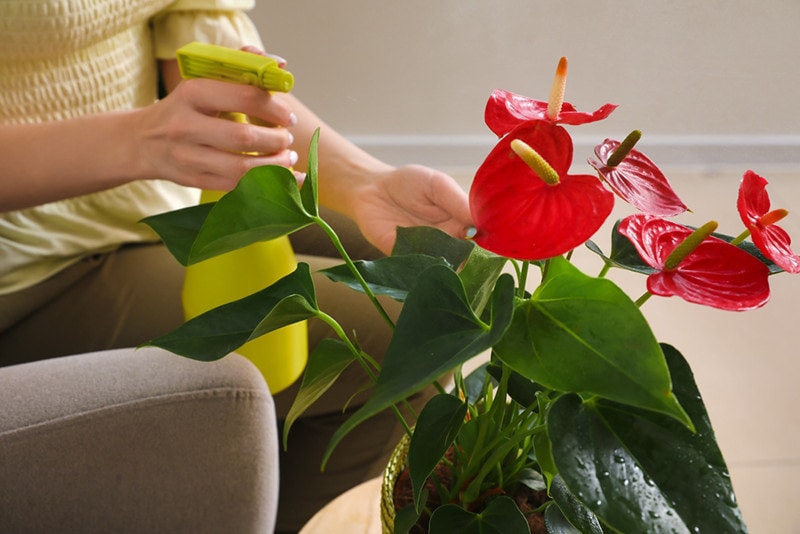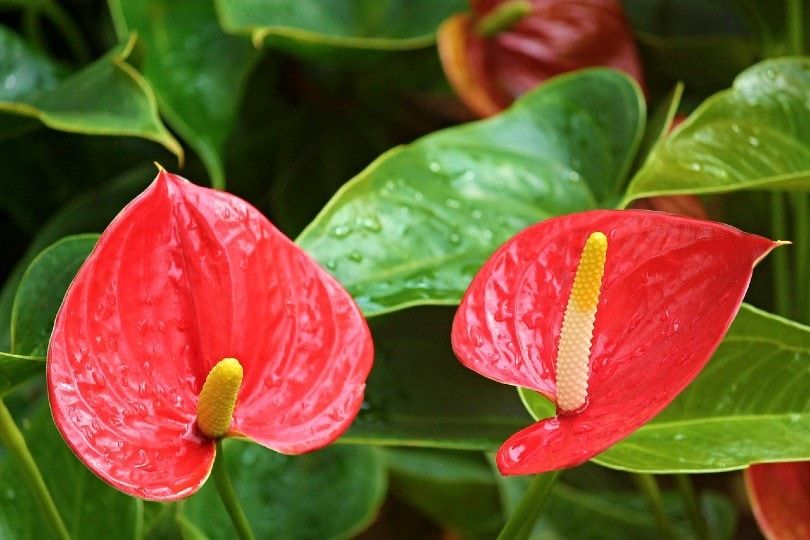Can You Grow Anthurium Plants Indoors? The Interesting Answer!
-
Codee Chessher
- Last updated:

Yes, you can grow Anthurium indoors, and it may even be your only option if you don’t live in a warm climate. Anthurium is a genus of flowering plants with over 1,000 distinct species, but most people know them as flamingo flowers. They grow natively in tropical regions like the Caribbean, Central America, and South America, but many people grow them as perennial houseplants or in greenhouses.
Anthurium is known for its large, leaf-like red, green, and white flowers, which are actually a type of waxy foliage. Indoors, Anthurium provides a tropical touch to any home, and they make great bedroom plants. They aren’t very finicky as long as you give them enough sun and water, blooming periodically for weeks at a time throughout the year.
Ideal Growing Conditions for Anthurium
As mentioned above, Anthurium are fairly low maintenance plants. They do prefer certain types of growing conditions to thrive, which helps maximize bloom times and reduce the gaps between them. We’ve broken up their preferred conditions into bite-sized chunks below: sunlight, water, soil, humidity, and temperature. Read on to learn more.
Sunlight
Like most tropical plants, Anthurium plants need a lot of sunlight. Preferably bright indirect sunlight, because their natural habitat is underneath tropical canopies, in hollow tree trunks, and on top of other plants.
Simply putting an Anthurium plant in a room that gets bright, unfiltered sunlight is usually enough to satisfy their sunlight needs, but you can put them on a windowsill if you’d like.

Water
Anthurium needs consistently moist but not saturated soil, and plenty of drainage holes to let water freely drain. Leave it alone for a while until the soil’s surface is dry to the touch, and then water again.
Watering too frequently risks inviting root rot. People colloquially refer to this as the plant-hating “wet feet.”
Soil
Coarse and loosely packed soil is ideal for Anthurium because it lets the soil freely drain. Respectively, amendments like compost, peat moss, and coarse sand can help improve soil structure, water retention, and drainage. Anthurium also prefers acidic soil with a pH between 5.5 and 6.0.
Humidity
Tropical plants like Anthurium need high humidity levels or their foliage will lose its lusciousness and wilt. 50% humidity is plenty enough, but 60% or more will help improve droopy Anthurium flowers. If you live in a dry climate, we suggest investing in a humidifier or regularly misting the plants.

Temperature
Anthurium plants prefer warmer weather and will die if left outside in temperatures below 40 degrees Fahrenheit, which is why they’re popular indoor plants. Temperatures between 65 and 85 degrees Fahrenheit are fine, but they like it warmer. There’s usually no need to crank the heat for your Anthurium except in freezing weather. You’d probably already have the heat on in such cases, anyway.
How to Grow Anthurium Indoors
We covered all the optimal growing conditions, but that doesn’t tell you exactly how to grow an Anthurium plant indoors. It’s fairly easy, even for beginners, but requires some attention to detail for your plant to thrive.
First, you’ll need a container with drainage holes, some gravel, and a tray. Put some water in the tray, cover it with rocks, and put your container on top. This system allows the soil to thoroughly drain into the tray, while the rocks provide a barrier from the tray’s water. The water in the tray helps satisfy the plant’s humidity needs.
Next is the soil. Anthurium likes coarse, loose soil, which most commercial orchid soils provide. You can use that as a base, but it won’t provide sufficient nutrition. To guarantee frequent, beautiful blooms, add green compost and a liquid fertilizer with a high phosphorus content. Use amendments like coarse sand and peat moss as necessary, depending on how well the soil drains.
Water and sunlight are easy. Just keep your Anthurium plant in a warm, humid room that gets a lot of bright indirect sunlight and water it when the soil’s dry to the touch.
Conclusion
Anthurium plants can yield gorgeous tropical blooms year-round, but they need warmth and humidity to thrive. Most people like the red ones, but some species have yellow and white flowers. Try mixing and matching the different types to create a tropical paradise in your home!
Featured Image Credit: Pixel-Shot, Shutterstock
Contents
